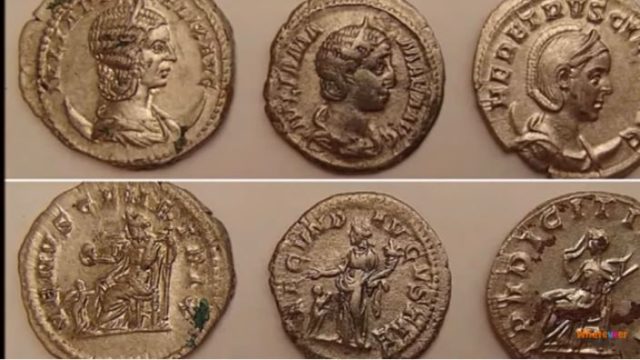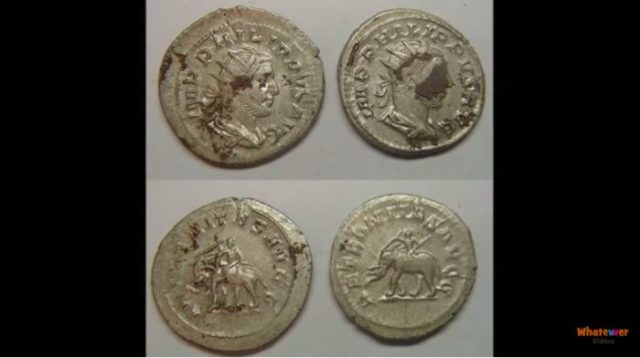While doing his normal work, a construction worker came across over 3,000 ancient Roman coins. The man was working as a JCB driver on a building site in Yeovil when he unearthed the hoard, which is roughly estimated to be worth over $250,000. The coins depict various emperors, an elephant, and a hippo.

The coins date back to the second and third centuries AD. This was when Romans marched through the village of Fosse Way. That village had been the main road between Exeter and Lincoln.
The man, Mark Copsey, discovered the hoard on March 20, 2013. He was leveling a recreation ground to make a hockey pitch when he noticed something green in the brown dirt. Copsey said that he was stripping the subsoil to get to the rock; when he was about 10 meters in he looked behind him and noticed the green color in the soil. He stopped his machine to get out and investigate the suspicious looking item. He then noticed that there was broken pot with coins in it.
Copsey knew that they had been valuable so he put them all in a plastic bag and reported his find. Archaeologists came to the site and took the coins away to be examined. In total, 3,339 coins were cleaned by The British Museum, where experts believe that the coins were buried around 270 AD. The stash includes 164 silver denarii coins, and four brass sestertii that were worth one denarii each. The rest of the coins are radiates much like the modern penny and without much value.
Some of those coins depict the heads of empresses and emperors; one had Philip I, who was born in Syria of a Syrian father in 204 AD. The denarii are believed to have come from the reigns of Antoninus Pius who ruled from 138 to 161 AD, Septimius Severus who ruled from 193 to 211 AD, Caracalla who ruled from 198 to 217 AD, Macrinus 217- 218 AD, Elagabalus 218- 222 AD, Severus Alexander 222-235 AD, Maximinus I 235 to 238 AD, and Gordian III 238 to 244 AD.
The British Museum’s historian said that the majority of the denarii, 49 of them, dated from the time when Severus Alexander was emperor. He relied on his charm and bribery in order to keep the peace.
The four sestertii were minted under the Roman Empress Faustina II, ruling from 130 to 175 AD, Lucilla, who was the second daughter of Roman Emperor Marcus Aurelius, and Commodus, who ruled from 180 to 192.
In regard to Roman currency, denarii coins were first minted in 211 BC. They were the most common coin in circulation and were worth 16 asses in the second century BC. Denarii were slowly debased in weight and their silver content reduced over time.
The British Museum also stated that some of those coins were made during a time of inflation and could have circulated during the third century BC. Among the hoard of coins there is one that has a likeness of Antoninus Pius, who ruled from 138 to 161 AD.
The museum’s coroner stated that the coins had been issued prior to the reign of emperor Septimius Severus, who ruled from 193 to 211 AD. The major debasement of those silver coins made earlier coins even more attractive to those who wished to remove them and take advantage of their high silver content. They are between 80 to 90 percent silver, while the ones that depict Severus are less than half silver.
By the end of the third century AD, the denarii only contained a small percentage of silver, a state that was disguised by applying a silver wash to the coin’s surface. When the coins were removed from the site, the museum experts found they were fused together in rolls with the remains of cloth and string preserved around them. This suggests that whoever buried it knew they were worth money and methodically stashed it. The shards of pottery found nearby suggest they were buried in the vessel.
After this find the site was gone through by archaeologists under the supervision of Yeovil Recreation Ground, the archaeologists found what looked to be a small Roman settlement.

When Copsey found the coins he said that he tried to act correctly so that he was not ruining any historical sites by touching anything he shouldn’t have. He also added that if he hadn’t looked behind him, like he always does, he may not have spotted the coins. He said that the bulldozer had sheared the pot clean off and if he had looked a little sooner he may have been able to save the pot as well. He’s hoping to find more artifacts in his next digs.
One of the other drivers on the site, Colin Parnell, tried arguing that he had also helped Copsey find the coins. However, the coroner Tony Williams ruled at a hearing that Copsey was the sole discoverer. He added that the hoard will be protected under the Treasure Act, which means Copsey will receive half of the value.
A coin expert in London, Chris Martin, said that early to mid-third century denarii are worth about 10 to 100 pounds each, radiates in silver are 10 to 50 pounds each, and sestertii could be worth anything between 20 to 100 pounds.
However, a marketing manager named Richard West believes that the coins will not reach lower than 20 pounds. This means that they will receive anywhere between 20 to 100 pounds for each coin in the hoard.
The Museum of Somerset hopes that the coins will go on display there so that the public can have a chance to see them.
